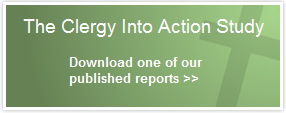People and organizations are primed for creativity in different ways—through the ways they interact socially, their approach to work, their general mental acuity and motivation, and their interests. These are also ways that people and organizations can foster environments in which creativity will (or will not) thrive.
In what ways are clergy more or less creative? The chart below shows how recently ordained Transition into Ministry (TiM) alumni compare with more seasoned Episcopal priests in their scores on ten subscales of the Cree Questionnaire (Baehr, 1959). These subscales reveal patterns of creative potential in social orientation, work orientation, mental and motivational engagement, and subject interest. The scores show how clergy “stack up” in comparison to a population of professionals from a wide variety of fields.
Clergy show high creative potential in some areas but not in others. Not surprisingly, clergy show a remarkably high preference for an autonomous and free-form work style. They are quite strong in coming up with new ideas quickly and spontaneously. They have a stronger interest in theoretical and artistic matters. But they are less energetic, slower, and less decisive in their reaction time, and less inclined to mechanical or structural matters than other professionals.
The general pattern suggests that clergy overall tend more toward independent creative thinking than toward organizational creative doing—they have particularly strong capacities for quickly thinking of great ideas and for working on their own, but their capacities for implementation are more moderate or weak in strength. As we found in responses to a question about creativity in our interviews with both groups, clergy find it easier to dream the ideas than to bring the ideas into reality.
Transition into Ministry alumni showed a similar pattern to more senior Episcopal priests in the types of creative work in which they excelled and those in which they were more challenged—but with some notable differences.
First, although TiM alumni’s ability to work independently was somewhat lower than more seasoned clergy, the TiM programs may have strengthened other creative capacities that were stronger than among seasoned Episcopal priests.1 For instance, TiM alumni tended to score somewhat higher in social dominance and self-confidence, and in their ability to work under pressure.2 These scores highlight TiM alumni as a group of emerging church leaders who have more experience and ease than their senior colleagues with turnaround response and delivery as well as greater ease with exercising strong social presence and self-confidence.
Second, TiM alumni clergy show an even stronger tendency than seasoned Episcopal priests toward being artists and dreamers who may nonetheless wrestle with the arts of implementation and organization of creative work. TiM clergy have even stronger interests in theoretical and artistic projects, and lower interests in things “mechanical” or structural.
They also report themselves having lower energy and a less speedy and decisive reaction time than their more seasoned Episcopal clergy colleagues. This last difference is surprising in an age in which the multitasking, responsorial world of web-based communication and information-searching might be expected to produce stronger self-reports of speedy reaction time. Perhaps reaction time is linked to the ability to focus one’s attention and set aside distraction, an increasing challenge in a multiple-stimulus world.
Overall, recently ordained clergy’s high-ideation and low-implementation tendencies in creativity can contribute to frustration in the experience of religious leadership of congregations and faith communities—frustration among clergy and congregation members alike.
Related Articles
- Research: Are Clergy Creative?
- Story: Ready or Not—A Senior Pastor Pushes for Innovation in Worship and Music
1 Alternatively, such capacities may also have preceded participation in TiM programs and contributed to the choices and selections of these individuals. Further examination of our data will help us tease out the effects of TiM programs from natural leadership capacities.
2 For an explanation of terms used in the administration and interpretation of the Cree Questionnaire (such as ideation and social dominance), we recommend the page about the Cree Questionnaire on the Praxis Partners website: www.praxispartners.ca/cree.html.



